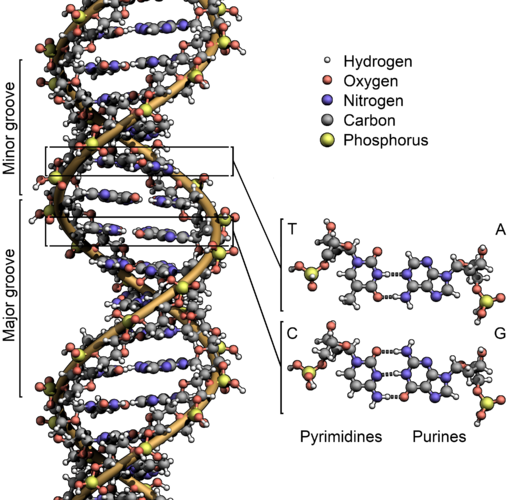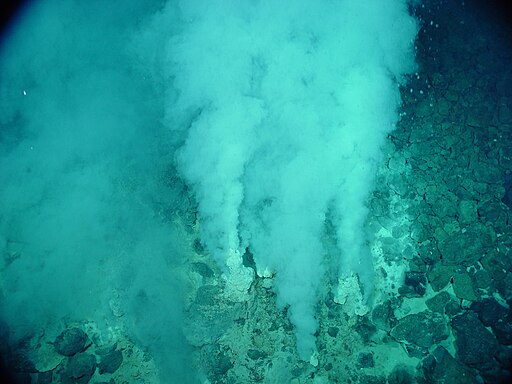10. First Life (~3.7 Ga)
Summary It seems that first life appeared on Earth in the beginning of the Archean Eon, around 3.7 billion years ago. In the beginning life forms only consisted of unicellular microorganisms, which are enclosed by a membrane and have long deoxyribonucleic acid (DNA) molecules in their centers which contain their genetic information. For the next about 3 billion years virtually all life consisted of microorganisms.
Keywords Chemistry; Evolution of Life; Hydrothermal Vents; Small Life

The deoxyribonucleic acid (DNA) which carries the genetic information of life forms. Its double helix shape was for the first time observed by Francis Crick and James Watson in 1953 by the X-ray diffraction technique. Important components of the DNA are the four nucleobases cytosine (C), guanine (G), adenine (A) and thymine (T), which primarily consist of the elements hydrogen, oxygen, nitrogen, carbon and phosphorus and whose sequence determines the nature and the behavior of its life form. (© User:Zephyris / Wikimedia Commons / CC-BY-SA-3.0)
It seems that first life on Earth appeared in the early Archean Eon, which succeeded the Hadean Eon and lasted from 4.0 billion years to 2.5 billion years ago – there is, however, also the possibility that it originated in the Hadean Eon itself.
The first life forms consisted of small microorganisms. While microorganisms are invisible to the unaided human eye – the earliest cells had a size of about one percent of the thickness of a human hair –, they could first be observed by humans in the late 17th century after the invention of the microscope. These small microorganisms – also called “Small Life” – were the only existing life forms during the bigger part of the evolutionary history of life. “Big Life” as we know it – large multicellular life forms like humans, sharks, mushrooms or mosquitoes – only appeared from about three billion years after the emergence of first life. The existence of large multicellular life forms is unthinkable without microorganisms which form the basis of the food chains. Furthermore, if life on extrasolar planets follows the same patterns as life on Earth, then planets hosting only microorganisms would be much more common in the Universe than planets hosting large multicellular life forms – not even to speak of their intelligence or technological capabilities.
There is no generally accepted definition of life. Microorganisms consist of single cells which are shielded to the outside by a membrane. This membrane controls which substance moves in and out and such ensures a constant environment inside the cell. The cells gain their energy by consuming energy-rich chemicals or sunlight, and they use that energy to build their own cellular components and to sustain their cellular processes – these chemical reactions are called metabolism. Inside the cell is the deoxyribonucleic acid (DNA), a long and compex replicating molecule, which contains the genetic information of the cell and determines its behavior. The cells can adapt to their environment and reproduce. There are also some overlaps between life and non-life: viruses, for example, contain DNA but do not have a metabolism.

First life could have originated around hydrothermal vents like this one. Hydrothermal vents are located on the seafloor at mid-ocean ridges and eject geothermally heated water and energy-rich chemicals. (© NOAA / Wikimedia Commons / Public Domain)
First life originated in oceans, and life also remained to be mostly aquatic for long times of history. Where and how life came into being is an ongoing research question: It could have evolved in hydrothermal vents, or it could also have originated on Mars and be brought to Earth by asteroid impacts.
